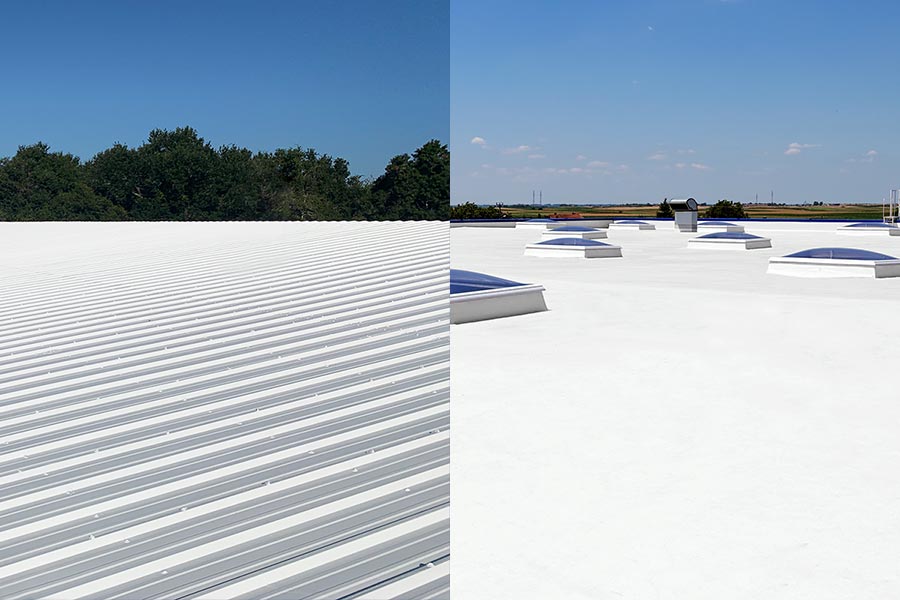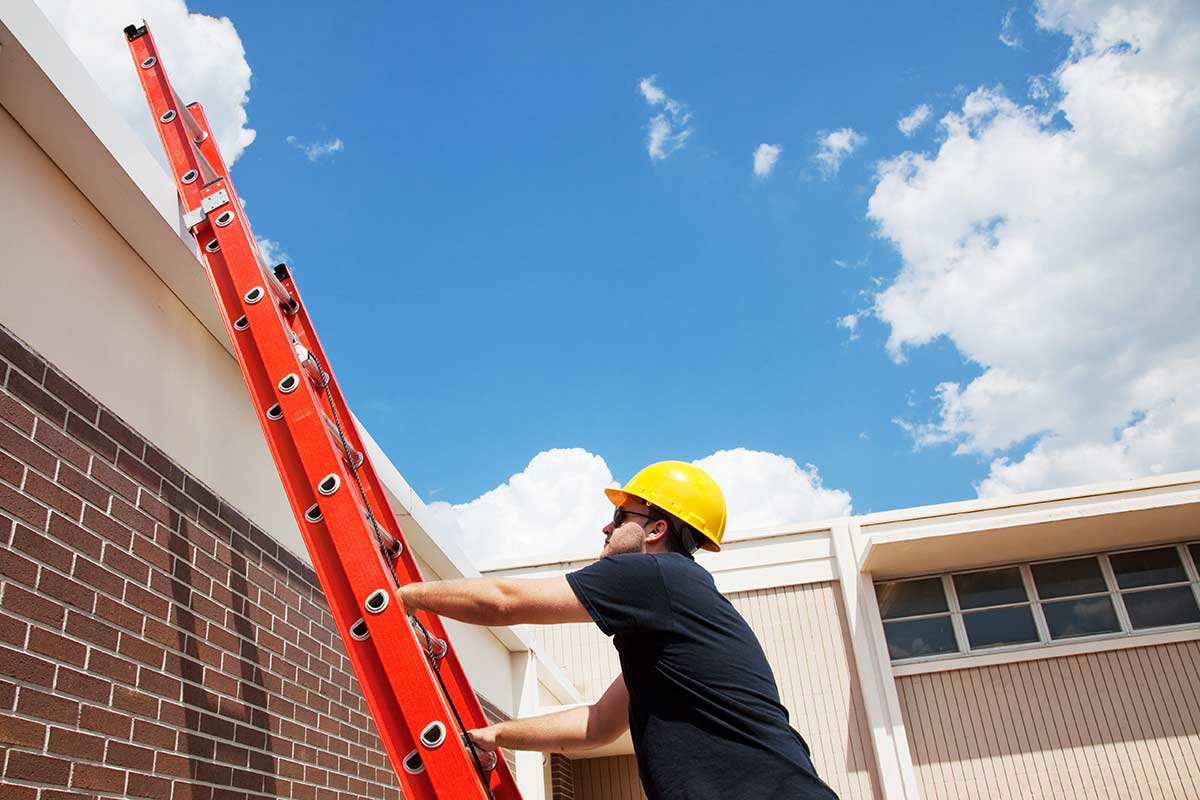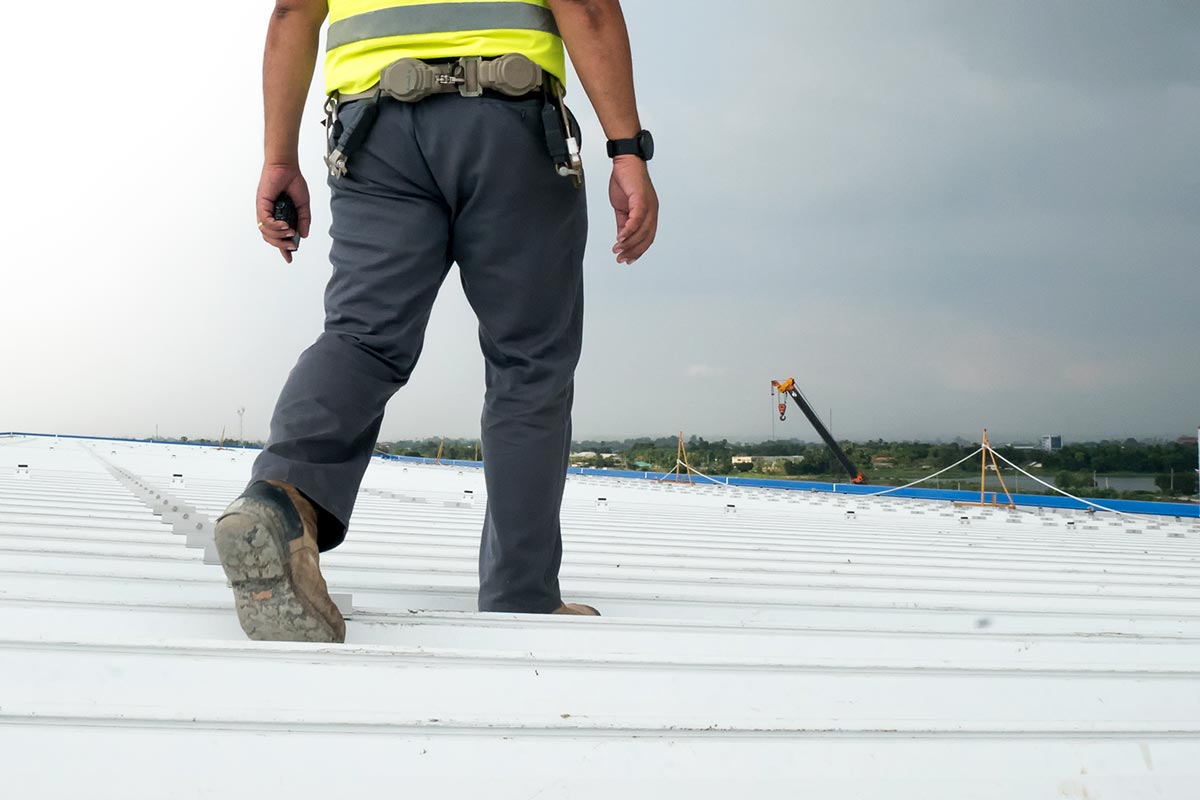
Over the years, roof restoration has become an increasingly popular alternative to roof replacement, yet it’s still a relative unknown to most commercial property owners and facility managers.
In an effort to inform those who may be unaware of the benefits of fluid-applied commercial roof restoration, the following is intended to serve as a complete and comprehensive overview of the restoration industry.
What is Roof Restoration?
Roof restoration (sometimes referred to as liquid roofing) is the process of renewing your existing roof to like-new condition with the use of elastomeric roof coatings.
Restoring your roof does not typically require the removal or replacement of any existing material—aside from any small portions of the roof that may be damaged or compromised.
The coatings that comprise commercial roof restoration systems are designed to fully encapsulate roof surfaces with a seamless, flexible, reflective, and watertight membrane.
There are numerous types of roof coating chemistries available in the industry (e.g., acrylic, butyl, silicone, and urethane). Most are suited to work on a wide variety of commercial roofing substrates including metal, modified bitumen, built-up roofs, PVC, TPO, EPDM, concrete, and spray polyurethane foam.
What Benefits Does Roof Restoration Provide?
Costs Less
Depending on the type of roof, a full replacement can cost anywhere from $5 to $20 per sq. ft. Restoration, on the other hand, provides all the advantages of a brand new roof but at a fraction of the cost. That’s because restoring a roof requires significantly less labor and material than conventional tear-off and replacement methods. As a result, you can expect to pay 50-70% less.
Extends Service Life
Perhaps the best quality of a restoration system is its ability to prolong roof life. The average commercial roof has a lifespan of about 20-25 years, but with restoration, you can add 10, 15, or even 20 years of serviceable life to your existing roof.
If properly installed and maintained, these systems can even be recoated multiple times—meaning you won’t have to worry about replacement anytime soon.
Improves Performance
The coatings that comprise restoration systems are developed to fully adhere to commercial roof surfaces. They provide a protective, monolithic, and watertight membrane that can effectively stop leaks and renew performance. They also significantly reduce the need for constant roof maintenance and repair.
Reduces Energy Costs
Roof restoration systems have excellent reflective and emissive qualities that can vastly improve the energy efficiency of your facility.
Unlike traditional roofing materials, the coatings that makeup restoration systems can reflect 80-90% of the sun’s UV radiation and diminish the transfer of heat to your building. This can drastically reduce HVAC system workloads and cut interior cooling costs by up to 20%.
Unconditioned spaces will benefit from decreased ambient temperatures, as well.
More Sustainable
In recent years, the demand for more sustainable roofing solutions has grown considerably due to stricter environmental regulations and building codes, as well as a growing concern for the environment.
Commercial roof replacements contribute millions of tons of waste to landfills annually. Restoration, however, requires no tear-off and has a minimal impact on the environment.
Less Disruptive
Unlike roof replacement, restoration is far less disruptive to building occupants and takes a fraction of the time to install—minimizing the impact on your day-to-day business operations.
At What Point Should You Restore Your Roof?
Ideally, you’ll want to restore your roof well before any problems start to arise. Day by day, your roof is slowly degrading, so a proactive approach is always recommended. The earlier in a roof’s lifespan that a restoration system is installed, the more likely it is to perform successfully in the longterm.
In any case, the roofing assembly must be structurally sound and free of wet or saturated insulation. For metal roofs, rust and corrosion can be present, but not to the extent where any panels are weakened or structurally unsafe.
Meet these criteria and your roof is likely a candidate to receive a restoration coating system. However, every roofing environment is different and there are other factors to consider.
Note: In order to determine if a roof is a candidate to receive a coating system, it is highly recommended that an adhesion test patch be performed.
How Does The Installation Process Work?
The restoration process is fairly simple. An experienced crew on an average size roof (about 20,000 sq. ft.) can typically complete a restoration project in 7 to 10 business days—weather permitting.
In most cases, the installation process can be broken down into four basic steps:
1. Surface Preparation
There’s a saying in this industry: “You’re only as good as what you stick to.”
That’s why the first and most important step of the installation process is to pressure wash the existing roof to remove any dirt, dust, debris, and other foreign contaminants. This ensures the coating system will fully adhere to the underlying roof membrane.
In some cases, a primer may be used to achieve optimal adhesion.
2. Seams & Details
After surface preparation, all seams, transitions, penetrations, fasteners, drains, and other flashing details of the roof are coated with a thick waterproofing mastic. This enables the system to expand and contract (thermal movement) as temperatures fluctuate on the roof surface.
It is important to address these components beforehand, as they are the most likely spots for leaks to occur.
3. Base Coat Application
Next, an elastomeric base coating is applied to the roof surface. This allows installers build and maintain uniform mil thickness of the coating throughout the installation process.
Many base coat material formulations reduce the need for a primer as they are specifically developed for maximum adhesion to a wide variety of commercial roofing materials.
Note: Some system application guidelines may require subsequent “intermediate” coats in order to achieve the proper dry film thickness (DFT).
4. Top Coat Application
Lastly, a top coat application provides the system with UV stability and moisture protection.
Most top coats form a bright-white membrane that provides the optimal amount of reflectivity, however, they can be custom-tinted to a variety of colors.
What Type of Application Equipment Is Used?
There are three primary methods for applying elastomeric coatings to commercial roof surfaces. Choosing the most efficient method depends on a variety of factors such as roof type, roof construction, product chemistry, time of year, and contractor preference, just to name a few.
Airless Sprayer
Airless sprayers, more commonly known as spray rigs, are widely considered the most efficient method of applying elastomeric coatings to roof surfaces. This type of equipment, however, can be quite expensive and generally requires some degree of technical knowledge to properly operate and maintain.
Airless sprayers use a hydraulic pump to atomize coating materials into a fine “sprayable” form. Because elastomeric coatings are much more viscous than regular paint materials, these rigs require much higher pressures and flow rates than conventional paint sprayers.
Tank Spreader
A relative newcomer to the industry, tank spreaders are quickly becoming the go-to choice for many roof coating contractors. Not only are they effective, but they’re also inexpensive and easy to use.
The most significant advantage of a tank spreader is its simple “gravity-fed” design. Roof coatings are poured into a reservoir (tank), and as the operator pulls the spreader along, the coating material cascades down onto an application roller. For metal roofs, specialized rollers are available to match specific profiles.
This method of application is great for achieving consistent mil coverage and also reduces the risk of overspray that can potentially occur when using an airless sprayer.
Nap Roller
Using a nap roller is the simplest way of applying coatings to roof surfaces. This method is usually reserved for smaller roofing applications or for isolated roof areas where access might be limited.
Note: Regardless of the application method, the use of a wet mil gauge is strongly recommended in order to properly measure and maintain proper wet film thickness throughout the installation process.
How Long Does a Restoration System Last?
Generally speaking, most commercial roof restoration systems are warrantied to last anywhere from 10, 15, or 20 years. Beyond that, additional coatings are going to be needed in order to sustain performance.
As far as the warranty is concerned, the term length of a restoration system is mostly determined by how much material is applied to the roof. For example, our Ure-A-Sil System installed on a modified bitumen roof with a 10-year warranty requires a total dry film thickness of 30 mils, while a 20-year warranty requires a dry film thickness of 40 mils.
Using the specifications outlined above, the Ure-A-Sil System will perform adequately for the term length of the warranty—assuming the system is properly installed and maintained.
Ready to Take the Next Step?
Think fluid-applied roof restoration is right for your commercial facility? Click here to schedule a free roof inspection with an American WeatherStar Approved Contractor.
Related Posts
Which Roof Coating Performs Best?
There are many variables to consider when it comes to the performance, longevity, and suitability of an elastomeric roof coating. Below, we…
How to Establish a Roof Maintenance Program
The most important reason for establishing a roof maintenance program is to protect the capital investment of a new roof. Proper maintenance…
5 Commercial Roof Maintenance Best Practices
Having a solid plan for commercial roof maintenance and repairs is critical to keeping your roof strong and preventing premature roof failure.…













